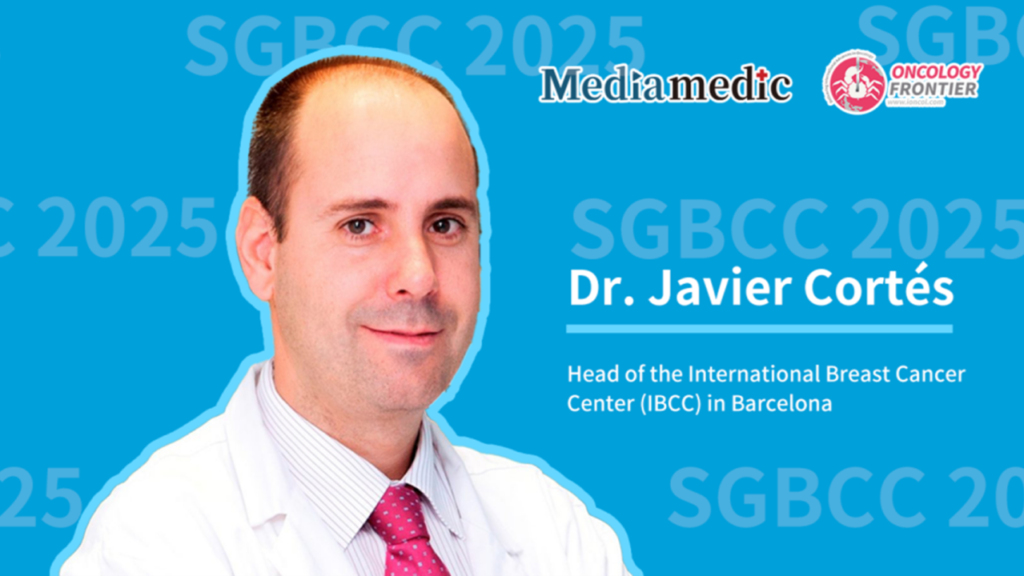
From March 12 to 15, 2025, the 19th St. Gallen Breast Cancer Conference (SGBCC 2025) was held in Vienna, the City of Music. Leading global experts in breast cancer gathered to discuss cutting-edge advancements and hotly debated topics in breast cancer diagnosis and treatment. At the conference, Dr. Javier Cortés, Head of the International Breast Cancer Center (IBCC) in Barcelona, Spain, delivered an insightful keynote speech titled "New anti-HER2 approaches—moving up to the (neo)adjuvant setting?" Oncology Frontier invited Dr. Javier Cortés to share his perspectives and outlook on (neo)adjuvant therapy for early HER2-positive breast cancer.Oncology Frontier:Could you share your feelings about participating in the 2025 SGBCC and the far-reaching significance of hosting this grand event?
Dr. Javier Cortés:Thank you very much for inviting me to be here with you.When attending conferences like this, we interact with colleagues and learn from each other. At the SGBCC, we learn a lot about early breast cancer strategies. This is a meeting that does not only include medical oncology perspectives but also all the specialties, including radiation therapy, pathology, surgery, and radiology. We work together and try to optimize the way we treat our patients, and clearly disseminate these findings. We will be able to interact with each other much better .
Oncology Frontier:At this SGBCC conference, you presented on the topic: “New anti-HER2 approaches – moving up to the (neo)adjuvant setting?” Could you elaborate on the novel anti-HER2 therapies that have entered or are poised to enter the (neo)adjuvant treatment stage? Which one do you consider the most promising and why?
Dr. Javier Cortés:In the last few years, we have learned that what happens in a metastatic setting does not always translate into the early breast cancer setting. Last year, we saw a great improvement in the outcomes of HER2-positive metastatic breast cancer. We have drugs such as pertuzumab, Trastuzumab、ADC,and T-DXd, which have shown improvements in long-term outcomes, progression-free survival, and overall survival. However, sometimes the way these drugs translate into improvements in the early-risk setting has not been so clear.
So in my opinion, we need to develop better clinical trial designs to optimize the improvements we expect. For example, we now have the example of the KATHERINE trial with T-DM1 in patients who have the worst prognosis—those who did not achieve pathological complete remission.
We are also exploring different drugs in the neoadjuvant setting. I think this is the way to move forward: to select the patient population with the worst outcomes to achieve better improvements. Last but not least, I think we need to change the way we design clinical trials and try to adopt more response-oriented strategies. For example, we might add or omit chemotherapy based on the response. Let’s go back 40 years to the period when we used to cut back on treatments. Let’s select those patients who we think will benefit most from these drugs.
Oncology Frontier:The development of innovative drugs often progresses from advanced-stage to early-stage applications. Could you discuss the necessity of this R&D pathway and the critical factors influencing a drug’s transition from late-stage to early-stage use?
Dr. Javier Cortés:Certainly, we need more and better drugs in early breast cancer, and this also applies to HER2-positive disease. It is true that today, the majority of patients with HER2-positive early breast cancer will be cured, but not all of them. So if we are unable to cure all of our patients, we need to improve the outcomes for all of them. This is why we need more and better drugs, some of which have been evaluated and/or approved in the metastatic setting. Examples include T-DM1 and tucatinib. These drugs should also be explored in the early breast cancer setting.
There are different approaches to selecting the optimal clinical trial design. The first is to select the patient population based on the risk of relapse. If we have higher-risk patients, we might anticipate higher benefits. But there are other ways to improve clinical trial designs. For example, instead of randomizing some patients to A versus B arms, maybe we should go for more innovative designs. Let’s go for a new strategy-based clinical trial. Remember, for example, the APHINITY trial with pertuzumab, which enrolled 4,000 patients in the early-risk setting in the adjuvant space. With these 4,000 patients, we all used pertuzumab. APHINITY was not for tiny tumors. So maybe we do not need to randomize thousands of patients. Maybe we have to design clinical trials in other ways. I’m really looking forward to exploring this possibility altogether.
Oncology Frontier:What are your expectations for the future of (neo)adjuvant treatment in early-stage HER2-positive breast cancer?
Dr. Javier Cortés:I think it’s difficult to predict the future of new adjuvant approaches in the HER2-positive field because today we have very good outcomes. We have trastuzumab, pertuzumab, and chemotherapy as the standard of care for stage II and stage III. We have started to design DS-8201 clinical trials. I think that in the future, we will see very good outcomes with less treatment. But it’s true that we also need to escalate the strategies for a group of patients. First, we have to identify much better who the patients are who need more. Second, we need to identify much better those who need less. And this can be done with a different type of trial. I think that some of the drugs which have been approved in a metastatic setting will also be approved in the early breast cancer setting. The point here is how to optimize the value of these drugs—again, through better patient selection and better clinical trial designs.


